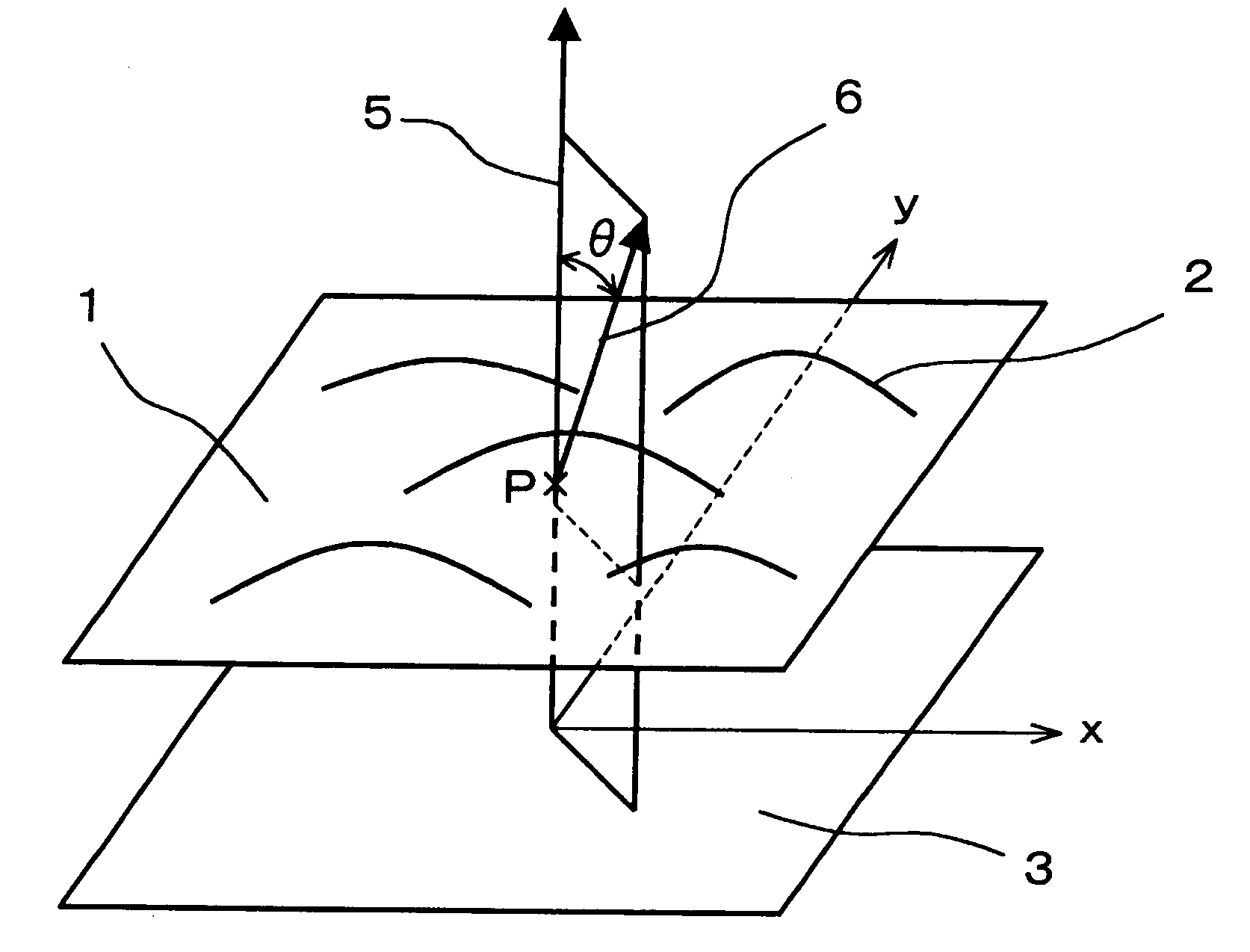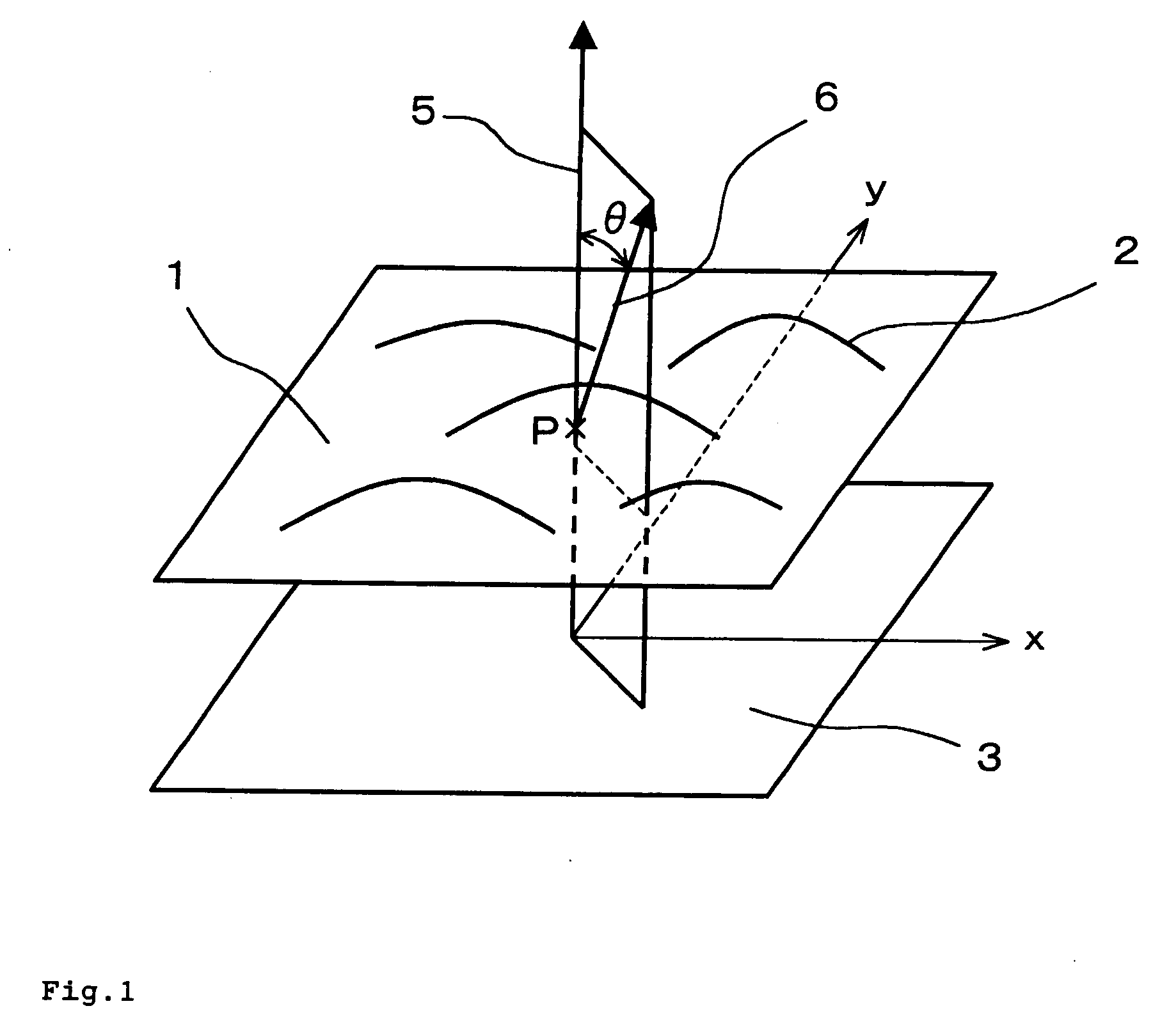Anti-glare optical film and process for preparing the same
an optical film and anti-glare technology, applied in the field of optical films, can solve the problems of deteriorating the visibility of an image displaying device including a liquid crystal displaying device, high cost of former non-reflecting treatment, and inability to be said, so as to reduce the whitening of a screen, prevent glare, and reduce the effect of whitening
- Summary
- Abstract
- Description
- Claims
- Application Information
AI Technical Summary
Benefits of technology
Problems solved by technology
Method used
Image
Examples
example 1
[0098]A soda-lime glass having a thickness of 1.1 mm obtained from Nippon Sheet Glass Co., Ltd. was blast-treated with a mono disperse aluminum crystal “Sumicorundum AA-5” (average particle diameter: 5 μm) obtained from Sumitomo Chemical Co., Ltd. A blast pressure was 0.5 kg / cm2 (50 kPa), and a blast time was 120 seconds. Thus blast-treated glass was ultrasound-washed, dried, immersed in 10% by weight hydrofluoric acid at 40° C. for 1,200 seconds, sufficiently washed with pure water, and dried to prepare a template glass.
[0099]10 g of a urethaneacrylate ultraviolet curing resin “UA-1” obtained from Shin-Nakamura Chemical Co., Ltd., and 0.5 g of a photopolymerization initiator “Lucirin TPO” (chemical name: 2,4,6-trimethylbenzoyldiphenylphosphine oxide) obtained from BASF Corporation were dissolved in 10 g of ethyl acetate to prepare a coating solution. This coating solution was coated on one side of triacetylcellulose film having a thickness of 80 μm obtained from Fuji Photo Film Co....
example 2
[0103]According to the same manner as that of Example 1 except that a blast particle was changed to “Sumicorundum AA-18” (average particle diameter: 18 μm) obtained from Sumitomo Chemical Co., Ltd., a blast pressure was 0.4 kg / cm2 (40 kPa), and a blast time was 120 seconds, an anti-glare optical film was prepared. Results of optical property and visible assessment of the resulting film are shown in Table 1. It was found that this film also has sufficient anti-glare property and whitening preventing ability.
example 3
[0108]A borosilicate glass plate (trade name “Pyrex”; 5 cm square, 4 mm thickness; purchased by designating size and thickness) manufactured by Asahi Techno Glass Co., Ltd. was blast-treated using a zirconia bead (trade name “TZ-B53”, average particle diameter 53 μm, approximately monodisperse) manufactured by Tosoh Co., Ltd. An amount of a blast agent (zirconia bead) used was 100 ml, a blast pressure was 0.03 MPa, a distance from a blast nozzle to a glass plate was 40 cm, and a blast gun was fixed. Blast treatment was completed in about 5 minutes. A glass after blast treatment remained approximately transparent, but when observed with a reflection-type microscope manufactured by Keyence Corporation, it was confirmed that many fine cracks were produced on the surface at a depth of about 1 to 1.5 μm.
[0109]A glass after blast was immersed in an etching solution of weight ratio 5 / 1 / 1 / 10 of hydrogen fluoride (HF) / ammonium fluoride ((NH4)2 SO4) / sulfuric acid (H2SO4) / water at a temperatur...
PUM
| Property | Measurement | Unit |
|---|---|---|
| average particle diameter | aaaaa | aaaaa |
| average diameter | aaaaa | aaaaa |
| reflection clarity | aaaaa | aaaaa |
Abstract
Description
Claims
Application Information
 Login to View More
Login to View More - R&D
- Intellectual Property
- Life Sciences
- Materials
- Tech Scout
- Unparalleled Data Quality
- Higher Quality Content
- 60% Fewer Hallucinations
Browse by: Latest US Patents, China's latest patents, Technical Efficacy Thesaurus, Application Domain, Technology Topic, Popular Technical Reports.
© 2025 PatSnap. All rights reserved.Legal|Privacy policy|Modern Slavery Act Transparency Statement|Sitemap|About US| Contact US: help@patsnap.com



